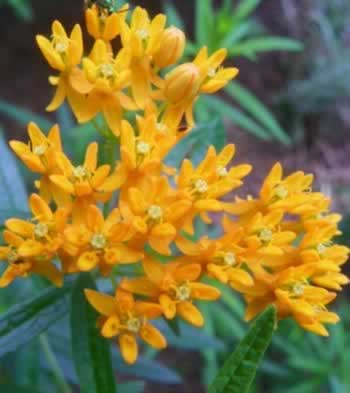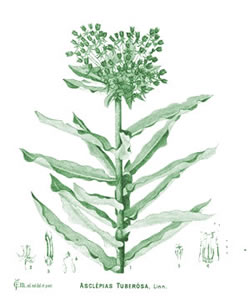Pleurisy Root Asclepias tuberosa

Orange butterfly weed
- Common Names
- Pleurisy Root , Butterfly-weed. Swallow-wort, Tuber root, Wind root, Colic root, Orange Milkweed
- Botanical Name
- Asclepias tuberosa
- Family
- ASCLEPIADACEAE
Medicinal Uses & Benefits of Pleurisy Root
![]() How to Use|
Side Effects |
Plant & Garden|
Folklore
How to Use|
Side Effects |
Plant & Garden|
Folklore
- Medicinal Uses: * Amenorrhea
* Congestion
* Cough
- Properties: * Antispasmodic * Astringent * Cathartic * emetic * Expectorant * Stomachic
- Parts Used: root
- Constituents: glycosides including asclepiadin, and possibly cardiac glyco-sides; volatile oil, resins
How to Use: Pleurisy Root
Pleurisy root gets its name from its medicinal uses against a wide range of respiratory and lung conditions specifically pleurisy, inflammation of the lining of the lungs and chest (the pleura) that leads to sharp pains in the chest when you take a breath or cough. It was formerly official to the United States Pharmacopoeia for pleurisy, but outside the herbal community, this herb is best known as butterfly weed for its attraction of butterflies, particularly monarchs.
Preparation Methods & Dosage :Teas and extracts, rarely encapsulated.
Pleurisy Root Remedies
Pleurisy Root Side Effects: Large doses are emetic and purgative. The mature plant contains alkaloids that are toxic to livestock, and not recommended for women who are pregnant or breastfeeding, and children..
Plant Description

American Medical Plants, Millspaugh, C.1802[18]
Butterfly weed is a North American native perennial which occurs in dry/rocky open woods, glades, prairies, fields and roadsides. It typically grows in a clump to 1-3 feet tall and features clusters (umbels) of bright orange to yellow-orange flowers atop upright to reclining, hairy stems with narrow, lance-shaped leaves. These flowers are a nectar source for many butterflies and leaves are a food source for monarch butterfly larvae (caterpillars). Unlike many of the other milkweeds, this species does not have milky-sapped stems. 1
Regional Traditions :North America *
History and Traditions & Folklore
From early days this member of the milkweed family has been regarded as a valuable medicinal plant, one of the most important of the indigenous American remedies.The milkweeds (Asclepias) were name for Aesculapius, who is said to have learned his knowledge of healing from an apprenticeship to Cheiron, the centaur whose herbal and medical skills came directly from Apollo.











